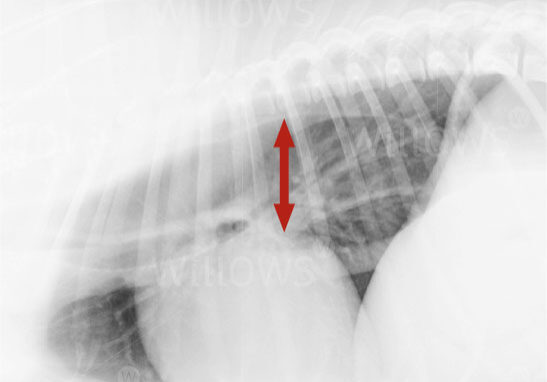Why Should I Bring my Pet to Willows for Megaoesophagus?
Willows is one of Europe’s leading small animal referral centres. Our state-of-the-art hospital is led by internationally renowned Specialists, committed to providing the highest standards of veterinary care. At Willows we have a dedicated team of Specialists in Internal Medicine and Diagnostic Imaging who have extensive experience in the diagnosis and management of patients with megaoesophagus.
Supporting the Specialists are a team experienced Internal Medicine nurses and clinical support staff who are available 24 hours a day every day of the year providing the best possible care patient care.
What is Megaoesophagus?
The oesophagus is a muscular tube that carries food and water from the back of the throat into the stomach. Usually this tube only dilates when food or water is being pushed along it, and otherwise it remains collapsed and empty. Megaoesophagus refers to a condition where the oesophagus becomes flaccid (floppy), weak and dilated. Food and water are no longer propelled down into the stomach and instead sit in the dilated oesophagus. This condition is most common in dogs and rare in cats.
What are the Most Common Causes of Faints or Fits?
Some dogs are born with megaoesophagus known as “congenital”. The breeds most commonly affected by congenital megaoesophagus are Great Danes, German Shepherds, Labrador Retrievers, Newfoundland’s, Chinese Sharpeis, Irish Setters, Miniature Schnauzers and Fox terriers. Siamese cats may be predisposed.
Megaoesophagus that occurs during adulthood is called ‘acquired’. There are a relatively large number of underlying diseases that can cause acquired megaoesophagus such as hormone, inflammatory, immune-mediated or structural disorders. If no underlying cause is found the megaoesophagus is termed ‘idiopathic’. An immune condition of the nerve-muscle junction called myasthenia gravis is one of the more common causes.
What are the Signs of Megaoesophagus?
Pets with megaoesophagus will regurgitate food and fluid either soon after eating or several hours later. It is important to distinguish between regurgitation and vomiting, as some owners may assume their pet is vomiting, when in fact he or she is regurgitating. Regurgitation, which is more commonly seen in cases of megaoesophagus, is a passive process where food or fluid is ejected from the oesophagus through the mouth and this will often occur quite quickly and is not associated with any retching.
Some dogs with megaoesophagus develop a discharge from the nose because regurgitated material passes from the back of the throat into the nose, where it causes irritation. A serious complication which can occur with megaoesophagus is aspiration pneumonia. This occurs when a patient regurgitates then inhales food, fluid or saliva down into the lungs. Depending upon the severity of the problem, patients with aspiration pneumonia will show a variety of signs, ranging from a mild cough through to rapid or laboured breathing – in severe cases the condition can be life-threatening. Some patients may develop aspiration pneumonia as their first obvious sign of megaoesophagus, as they may not have been seen to regurgitate if they generally swallow the regurgitated material.

How is it Diagnosed?
Megaoesophagus is diagnosed by taking x-rays of the chest. As sedative drugs or general anaesthesia can cause gas to build up in the oesophagus and mimic the appearance of a megaoesophagus, it is important that the x-rays are obtained without sedation or anaesthesia. Blood tests are performed to look for secondary causes (found in 30-40% of cases).
Image 1: Chest x-ray of a dog showing megaoesophagus (the arrow indicates the diameter of the oesophagus)

What are the Treatments Available?
There is no cure for megaoesophagus and no specific treatment is available. If an underlying disease which is causing the megaoesophagus is diagnosed, specific treatment for this disease will be prescribed, however in many cases once megaoesophagus has developed, it is a life-long problem. Antibiotics may be prescribed if aspiration pneumonia is present.
What Can I Expect if my Pet is Treated for Megaoesophagus?
Management for megaoesophagus usually involves feeding both food and water from an elevated position and keeping the patient upright during feeding and for several minutes afterwards to reduce the aspiration risk. A ‘Bailey chair’ is an adapted chair that can be made (similar to a child’s high chair) that the patient can be placed in for feeding.
Long term management: The prognosis for megaoesophagus is variable. Due to the ongoing risk of aspiration pneumonia and lack of curative treatment for the majority of patients the outlook is guarded but some patients do very well.
To save this page as a PDF, click the button and make sure “Save as PDF” is selected.
Internal Medicine
Find out more
To assist owners in understanding more about Internal Medicine we have put together a range of information sheets to talk you through the some of the more common Medicine conditions seen and treated by our Specialists.

